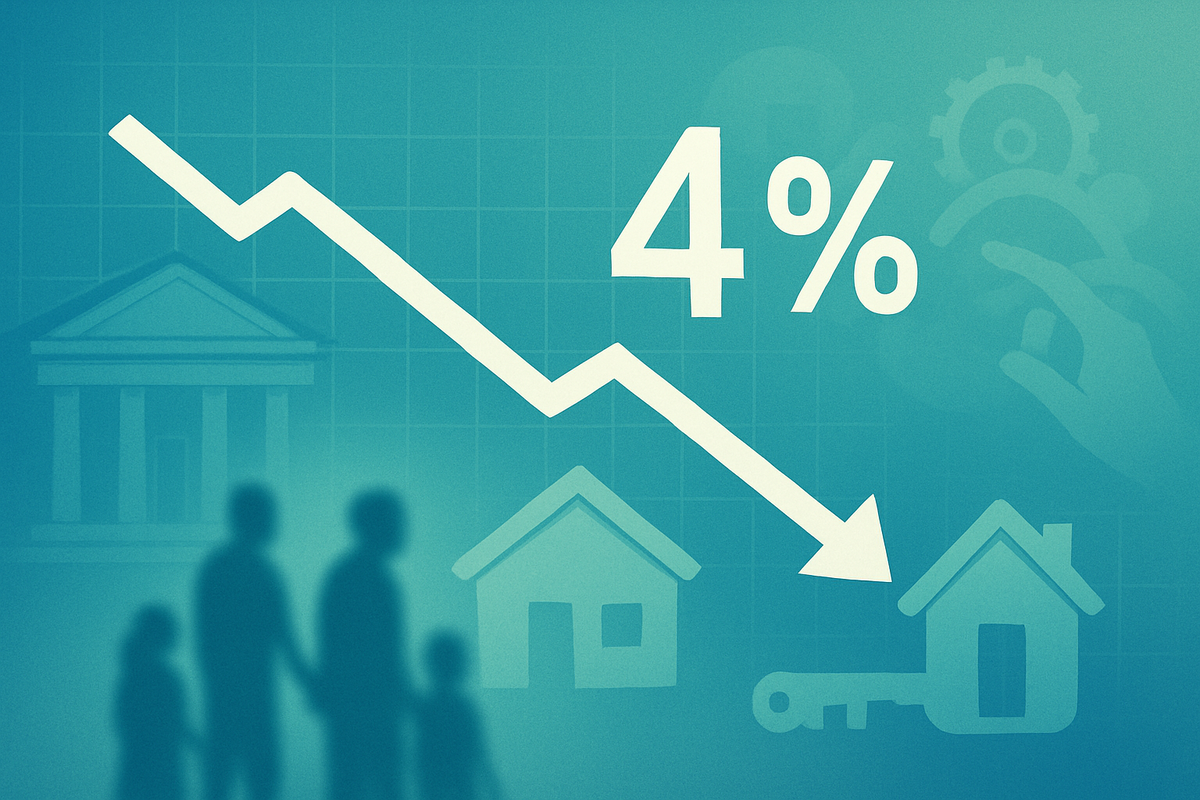
The U.S. housing market is holding its breath as mortgage rates hover near a significant three-year low, a compelling backdrop to the highly anticipated Federal Reserve interest rate decision slated for this week. This sustained period of lower borrowing costs presents a dual-edged sword: a potential boon for prospective homebuyers and a strategic challenge for the nation's central bank as it navigates a complex economic landscape. The outcome of the Fed's meeting is expected to send ripples across the financial sector, influencing everything from lending practices to consumer confidence.
For weeks, the average 30-year fixed mortgage rate has danced around the 5.99% to 6.21% mark, a welcome reprieve from the higher rates seen earlier in the year. This dip, which briefly touched a three-year low of 6.13% in mid-September 2025, has ignited hopes of increased affordability and a potential resurgence in housing market activity. However, with the Federal Open Market Committee (FOMC) scheduled to conclude its meeting on October 29, 2025, at 2:00 PM ET, the market remains in a state of cautious optimism, keenly awaiting clarity on the future trajectory of interest rates.
The Fed's Tightrope Walk: Easing Policy Amidst Economic Shifts
The current favorable mortgage rate environment is not an accident but rather a direct consequence of several evolving economic factors and the Federal Reserve's strategic pivot towards easing monetary policy. Throughout 2025, mortgage rates have been on a gradual downward trend, falling from a peak of 7.04% in January. This trajectory has been primarily driven by a softening labor market, characterized by slower job growth and an uptick in unemployment claims, which typically prompts the Fed to consider rate cuts to stimulate economic activity.
Adding to the impetus for lower rates is the moderating inflation data. While still above the Fed's targeted 2%, recent Consumer Price Index (CPI) reports for September 2025 have shown signs of cooling, providing the central bank with more flexibility to adjust its policy. Furthermore, the yields on 10-year Treasury bonds, which mortgage rates often track, have seen downward pressure as investors seek safer assets amidst broader economic uncertainties, including the ongoing government shutdown that has delayed the release of crucial economic data. The Fed already implemented a rate cut in September 2025, and market consensus overwhelmingly anticipates another 25-basis-point (0.25%) reduction this week, which would lower the federal funds rate target range to 3.75% to 4.00%. This would mark the second consecutive rate cut, with further reductions expected into late 2025 and 2026.
However, the market's reaction to the Fed's announcement might not be as straightforward as a direct drop in mortgage rates. Financial markets have largely "priced in" the expected rate cut, meaning many lenders have already adjusted their offerings in anticipation. Historically, mortgage rates can sometimes experience a brief uptick immediately following a Fed decision if the announcement or the accompanying commentary from Fed Chair Jerome Powell suggests a more cautious approach to future cuts than investors had hoped. For key players like mortgage lenders, including major banks such as JPMorgan Chase & Co. (NYSE: JPM) and Wells Fargo & Company (NYSE: WFC), the period leading up to and immediately following the Fed's decision is critical for managing their portfolios and adjusting their lending strategies. Homebuyers, meanwhile, are caught between the allure of lower rates and the uncertainty of future market movements.
Corporate Fortunes: Who Wins and Who Faces Headwinds?
The prevailing low mortgage rates and the Federal Reserve's dovish stance will undoubtedly create winners and losers across various sectors of the financial market. Mortgage lenders stand to benefit significantly from a surge in refinancing activity. Homeowners who secured loans at higher rates in recent years are likely to seize the opportunity to reduce their monthly payments, driving up loan origination volumes for companies like Rocket Companies, Inc. (NYSE: RKT) and United Wholesale Mortgage (NYSE: UWMC). This increased demand for refinancing, coupled with a potential uptick in purchase mortgages, could bolster their revenue streams and profitability.
Homebuilders are another clear beneficiary. Companies such as D.R. Horton, Inc. (NYSE: DHI), Lennar Corporation (NYSE: LEN), and PulteGroup, Inc. (NYSE: PHM) could see renewed buyer interest as lower mortgage rates improve housing affordability. This could translate into higher sales volumes and potentially stronger stock performance, especially if inventory levels remain constrained. The lower cost of borrowing for consumers could stimulate demand, helping to alleviate some of the pressures from persistently high home prices and construction costs. Similarly, real estate companies and brokerages like RE/MAX Holdings, Inc. (NYSE: RMAX) and Zillow Group, Inc. (NASDAQ: Z) might experience an increase in transaction volumes, benefiting from a more active housing market.
On the other hand, traditional banks with large deposit bases, such as Bank of America Corporation (NYSE: BAC) and Citigroup Inc. (NYSE: C), might face pressure on their net interest margins (NIMs) if the federal funds rate continues to decline. Lower benchmark rates mean banks earn less on their lending activities, potentially impacting their overall profitability. While increased mortgage origination could partially offset this, a prolonged low-rate environment can squeeze their core banking operations. Furthermore, some highly leveraged Real Estate Investment Trusts (REITs), particularly those focused on commercial properties, might find their borrowing costs decrease, but the broader economic uncertainty could still weigh on their asset valuations and tenant demand.
Broader Implications: A Catalyst for Economic Revival?
The current state of mortgage rates and the Fed's anticipated action fit into a broader narrative of economic recalibration. The shift towards lower interest rates is a clear signal from the Federal Reserve that it is committed to supporting economic growth amidst signs of a slowdown. This move could catalyze a much-needed revival in the housing market, which often serves as a bellwether for the wider economy. A robust housing sector can spur consumer spending on home-related goods and services, benefiting retailers like Home Depot, Inc. (NYSE: HD) and Lowe's Companies, Inc. (NYSE: LOW).
The ripple effects extend beyond housing. Lower borrowing costs for businesses could encourage investment and expansion, potentially leading to job creation and increased productivity. From a regulatory perspective, the Fed's decision underscores its dual mandate of maintaining maximum employment and stable prices. By easing rates, the central bank aims to counteract the softening labor market and ward off potential recessionary pressures, even as it carefully monitors inflation. Historically, periods of sustained low interest rates have often preceded economic expansions, as seen in various cycles throughout the 2000s and 2010s, where affordable credit fueled growth. However, this also raises concerns about potential asset bubbles if liquidity becomes too abundant.
The current situation also highlights the interconnectedness of global financial markets. While the focus is domestic, international economic conditions and central bank policies abroad can influence U.S. Treasury yields and, consequently, mortgage rates. The ongoing government shutdown, though not directly a Fed policy, adds a layer of uncertainty, impacting data releases and potentially influencing the Fed's cautious stance, demonstrating how non-monetary policy events can have significant financial market ramifications.
The Road Ahead: Navigating Uncertainty and Opportunity
Looking ahead, the short-term outlook for mortgage rates hinges significantly on the Federal Reserve's commentary following its October 29 decision. While a 25-basis-point cut is largely priced in, any indication of a slower pace of future cuts or a more hawkish tone could cause rates to stabilize or even tick up temporarily. Conversely, a strong commitment to further easing could push rates slightly lower. Expert forecasts generally suggest that mortgage rates will likely remain in the mid-6% range for the remainder of 2025, with some projections from entities like Fannie Mae anticipating a decline to 5.9% by the end of 2026.
For prospective homebuyers, the current environment presents a critical window of opportunity. Experts advise locking in an affordable rate now, as market opportunities can be fleeting. The long-term possibilities point towards a potentially more accessible housing market, but challenges persist, particularly high home prices and limited inventory in many regions. Homebuilders may need to strategically pivot, focusing on increasing supply in high-demand areas and potentially offering incentives to capitalize on renewed buyer interest. Mortgage lenders will adapt by fine-tuning their product offerings and marketing efforts to capture both refinancing and purchase mortgage demand.
Potential scenarios range from a stable, low-rate environment that gradually stimulates housing and economic growth, to unexpected market volatility driven by unforeseen economic data or geopolitical events. Investors should closely monitor not only the Fed's future decisions but also inflation reports, employment figures, and global economic indicators. The interplay of these factors will dictate the trajectory of mortgage rates and the broader financial markets.
A Pivotal Moment for the Housing Market
In summary, the current holding pattern of mortgage rates near a three-year low, coupled with the imminent Federal Reserve interest rate decision, marks a pivotal moment for the U.S. housing market and the broader economy. The anticipated rate cut is a clear effort by the Fed to inject liquidity and stimulate growth, offering a potential lifeline to homebuyers and a boost to the real estate sector. While mortgage lenders and homebuilders stand to gain from increased activity, traditional banks may face pressure on their margins.
Moving forward, investors should pay close attention to the Federal Reserve's forward guidance, as this will provide crucial clues about the future path of monetary policy. The housing market's response to these lower rates, particularly in terms of sales volume and new construction, will be a key indicator of economic health. Any significant shifts in inflation or employment data could prompt the Fed to adjust its strategy, introducing fresh volatility. For now, the message is clear: opportunity knocks for those ready to enter the housing market, but vigilance remains paramount in an ever-evolving financial landscape.
This content is intended for informational purposes only and is not financial advice





